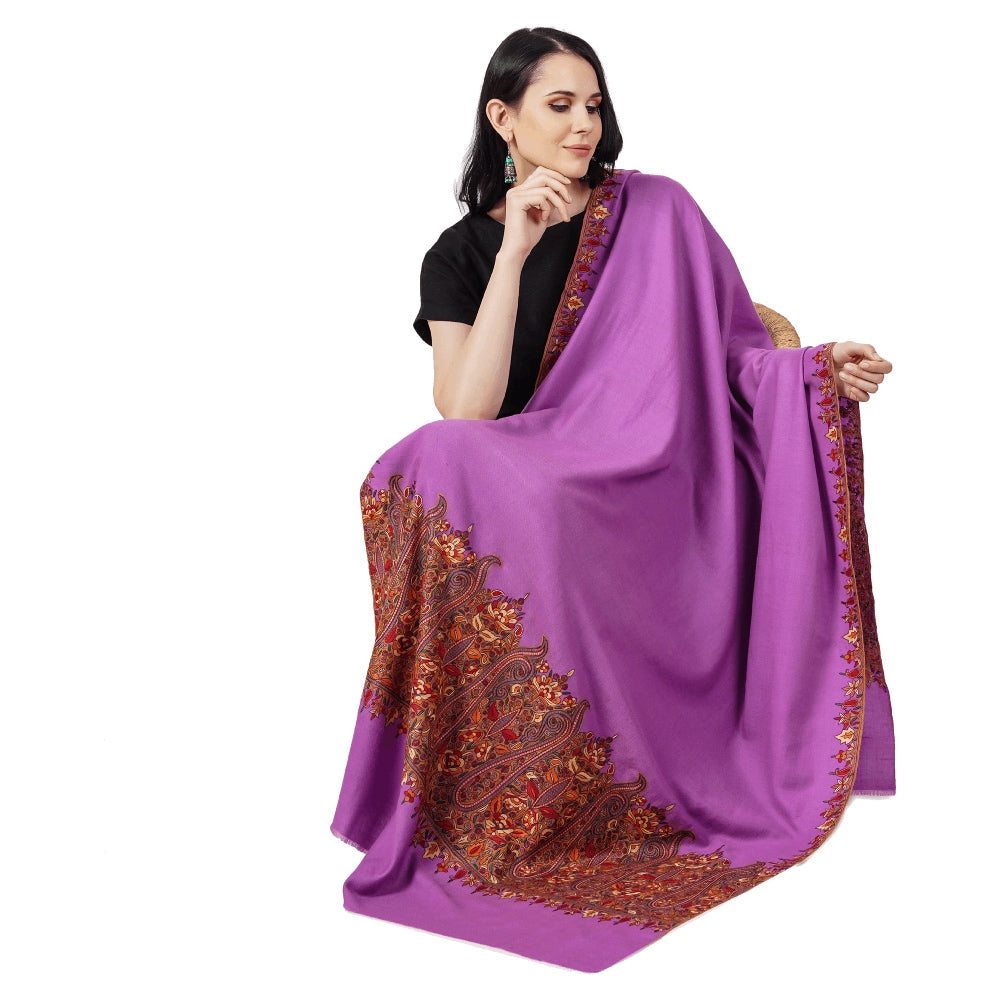
Crafting a Pashmina Shawl: Time & Expertise
Share

Pashmina shawls are a type of luxurious shawl made from the wool of the pashmina goat, which is native to the Himalayan region of Kashmir. The wool is known for its warmth, softness, and fine texture, and is considered to be one of the most precious and valuable natural fibers in the world.
Pashmina shawls are hand-woven and hand-spun, and are made using traditional techniques that have been passed down for generations. The wool is collected from the underbelly of the pashmina goat during the spring molting season, and is then carefully cleaned, combed, and spun into yarn.
The shawls are typically woven on a traditional wooden loom, using a combination of different techniques and patterns that create intricate designs and beautiful textures. The weaving process is slow and labor-intensive, with some shawls taking several weeks or even months to complete.
Pashmina shawls are known for their exceptional quality and craftsmanship, and are highly prized for their beauty and warmth. They are often considered to be a luxury item, and are popular as gifts and souvenirs in the Himalayan region and beyond.
Also read: What is so special about Pashmina Shawl?
The Art of Weaving Pashmina Shawls

Overview of the weaving process Factors affecting the time required for weaving a Pashmina shawl Detailed explanation of the different steps involved in weaving a Pashmina shawl
The weaving process for Pashmina shawls is a complex and time-consuming process that requires a high level of skill and expertise. The process can take anywhere from several days to several months, depending on the complexity of the design and the skill level of the weaver.
The time required for weaving a Pashmina shawl is affected by several factors, including the intricacy of the design, the quality of the wool, and the skill level of the weaver. Generally, the more complex the design and the finer the wool, the longer it will take to weave the shawl.
Also read: The making of Pashmina Shawl
The weaving process for Pashmina shawls typically involves the following steps:
Spinning the yarn

Spinning the yarn for pashmina shawls is a delicate and intricate process that requires great skill and attention to detail. The wool used for pashmina shawls is obtained from the underbelly of the pashmina goat during the spring molting season, when the fibers are at their finest and softest.
After the wool is collected, it is carefully sorted, washed, and combed to remove any impurities and tangles. The wool fibers are then hand-spun into yarn using a traditional spinning wheel or spindle.
The spinning process requires a great deal of skill and practice, as the spinner must maintain a consistent tension and thickness in the yarn. The resulting yarn is incredibly fine and delicate, with a softness and warmth that is unmatched by any other fiber.
Once the yarn has been spun, it is ready to be woven into a shawl using a traditional wooden loom. The weaver carefully selects the colors and patterns for the shawl, and then sets to work creating a beautiful and intricate design that showcases the natural beauty of the pashmina wool.
Dyeing the yarn:

Dyeing the yarn for pashmina shawls is another important step in the production process, as it adds color and depth to the final product. The dyeing process is typically done by hand, using natural dyes made from plant or mineral sources.
The first step in the dyeing process is to prepare the yarn by washing it thoroughly to remove any dirt, oil, or other impurities that could interfere with the dye uptake. The yarn is then soaked in a mordant solution, which helps the fibers to absorb the dye more effectively and also helps to fix the color.
Once the yarn has been mordanted, it is ready to be dyed. The dyestuffs are prepared by boiling them in water or another solvent, and then the yarn is immersed in the dye bath. The yarn is gently agitated to ensure that the color is distributed evenly, and then left to soak for several hours or overnight.
After the yarn has been dyed, it is rinsed thoroughly to remove any excess dye and then hung to dry. The process may be repeated several times to achieve the desired depth and intensity of color, and different colors may be applied in successive layers to create complex patterns and designs.
Natural dyes are often preferred for pashmina shawls, as they are eco-friendly and non-toxic, and can create a range of beautiful and unique shades. Some common natural dyes used for pashmina shawls include indigo, madder root, walnut husks, and pomegranate rind.
The next step is to dye the yarn in the desired colors. The yarn is soaked in a dye bath and then dried.
Setting up the loom:

Setting up the loom for weaving pashmina shawls is a complex process that requires a great deal of skill and attention to detail. The loom used for pashmina shawls is typically a traditional wooden loom, which consists of a frame, a warp beam, and a cloth beam.
The first step in setting up the loom is to wind the warp threads onto the warp beam. The warp threads are the vertical threads that run the length of the shawl, and are held under tension by the warp beam. The weaver carefully winds the threads onto the warp beam, ensuring that they are evenly spaced and under the correct tension.
Once the warp threads have been wound onto the beam, they are threaded through the heddles and the reed. The heddles are small metal or wooden frames that are used to raise and lower the warp threads, while the reed is a comb-like device that is used to push the weft threads through the warp threads.
The weft threads, which are the horizontal threads that run across the shawl, are then wound onto the shuttle. The shuttle is a small wooden tool that is used to carry the weft threads back and forth across the warp threads.
Once the loom has been set up, the weaver can begin weaving the shawl. The weaver carefully selects the pattern and color of the weft threads, and then sets to work creating a beautiful and intricate design that showcases the natural beauty of the pashmina wool. The weaving process is slow and labor-intensive, and can take several weeks or even months to complete a single shawl.
Weaving the shawl:

Weaving a pashmina shawl is a complex and time-consuming process that requires great skill and attention to detail. Once the loom has been set up, the weaver can begin weaving the shawl.
The weaver starts by passing the shuttle through the warp threads to create the first row of weft threads. The weft threads are then beaten down using the reed, which pushes them tightly against the previous row of weft threads.
The weaver continues weaving the shawl row by row, carefully selecting the color and pattern of the weft threads and adjusting the tension of the warp threads as needed. As the shawl grows, the weaver must carefully monitor the pattern and ensure that it is consistent throughout.
Pashmina shawls are known for their intricate designs and beautiful textures, which are created using a variety of weaving techniques such as twill, herringbone, and basket weave. Some shawls also feature embroidered or embellished designs, which are added to the finished shawl after the weaving process is complete.
The weaving process can take several weeks or even months to complete a single shawl, depending on its size and complexity. Once the shawl is finished, it is carefully removed from the loom and checked for any errors or imperfections. Any loose threads or other imperfections are carefully trimmed and the shawl is then washed, pressed, and blocked to give it its final shape and texture.
Finishing the shawl:
Finishing a pashmina shawl is an important step in the production process that gives the shawl its final shape, texture, and appearance. The finishing process typically involves several steps, including washing, blocking, and trimming.
The first step in finishing the shawl is to wash it to remove any dirt, oil, or other impurities that may have accumulated during the weaving process. The shawl is carefully washed by hand in cool water with a gentle soap or detergent, and then rinsed thoroughly to remove all soap residue.
Once the shawl has been washed, it is carefully blocked to give it its final shape and size. Blocking is the process of stretching the shawl out on a flat surface and pinning it in place to ensure that it dries in the desired shape. This step is critical for ensuring that the shawl maintains its shape and texture over time.
After the shawl has been blocked, it is trimmed to remove any loose threads or other imperfections that may have been missed during the weaving process. The weaver carefully inspects the shawl for any flaws or errors, and then trims them away using a pair of scissors.
Finally, the shawl is pressed to give it a smooth and even texture. This is done using a special press or iron, which is used to gently smooth out any wrinkles or creases in the shawl.
Once the finishing process is complete, the shawl is ready to be sold or worn. Pashmina shawls are prized for their beauty, warmth, and softness, and are often passed down as heirlooms from one generation to the next.
Time Required for Weaving a Pashmina Shawl
The average time required for weaving a Pashmina shawl Factors affecting the time required Comparison of time required for weaving a Pashmina shawl with other types of shawls
The time required for weaving a Pashmina shawl can vary widely depending on the complexity of the design and the skill level of the weaver. On average, it can take anywhere from 2 to 6 weeks to weave a Pashmina shawl.
Several factors can affect the time required for weaving a Pashmina shawl, including the intricacy of the design, the quality of the wool, and the skill level of the weaver. Generally, the more complex the design and the finer the wool, the longer it will take to weave the shawl.
In comparison to other types of shawls, Pashmina shawls typically take longer to weave due to the intricate designs and the fine quality of the wool. For example, a woolen shawl can take a few days to a week to weave, while a silk shawl may take several weeks.
Expert Opinions on Time Required for Weaving a Pashmina Shawl
As one of the oldest manufacturers and exporters of Kashmiri Pashmina Shawl we at Pashwrap holds expertise in the field of Pashmina weaving and can provide valuable insights into the time required for weaving a Pashmina shawl. A skilled weaver can weave a simple Pashmina shawl in about 10-15 days, while a more complex design can take up to 2-3 months to complete. The quality of the wool also plays a significant role in the time required, as finer wool requires more delicate handling and takes longer to weave.
Experts also note that the time required for weaving a Pashmina shawl is increasing due to the declining number of skilled weavers and the increasing demand for high-quality Pashmina shawls. Many weavers are also working to preserve traditional weaving techniques, which can add to the time required for weaving a Pashmina shawl.
Conclusion
Summary of key points Final thoughts on the time required for weaving a Pashmina shawl Implications for the Pashmina industry and its consumers
In conclusion, weaving a Pashmina shawl is a time-consuming and intricate process that requires a high level of skill and expertise. The time required can vary widely depending on the complexity of the design, the quality of the wool, and the skill level of the weaver. The declining number of skilled weavers and the increasing demand for high-quality Pashmina shawls are also contributing to longer weaving times.
Consumers of Pashmina shawls should be aware of the time and effort that goes into producing these luxurious garments. They should also be willing to pay a fair price for the high-quality craftsmanship that goes into each shawl. By supporting the Pashmina industry and its weavers, consumers can help to preserve this valuable cultural heritage for future generations.




